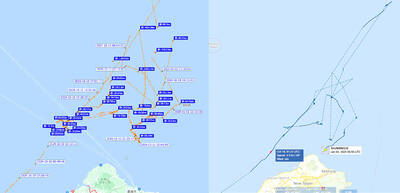Since November last year, trade with the 18 countries included in the government’s New Southbound Policy has greatly increased, recovering from a downturn caused by the COVID-19 pandemic, the Executive Yuan’s Office of Trade Negotiation said on Friday.
On a monthly basis, trade in November last year grew 12 percent from 1.8 percent in October, and then 15.5 percent in December, the office said.
Trade could grow even further if the region recovers from the pandemic this year, the office said, adding that it plans to expand projects in the region, including skills training, medical cooperation and start-up assistance.
The number of people from south and southeast Asia studying in Taiwan between 2016 and 2019 increased 84.8 percent, the office said, touting the policy’s success.
In the same period, the number of Taiwanese studying in those countries increased 34.9 percent, it added.
Also, over the period, sales of medical supplies to some countries in the region — mainly Vietnam, the Philippines, Malaysia, India, Thailand, Indonesia and Cambodia — increased 30 percent to US$374 million from US$290 million, it said.
Medical exports to those countries last year, following the start of the COVID-19 pandemic, increased 8.2 percent, it added.
Taiwanese businesses have also signed investment guarantee agreements with each of these countries to protect their rights, it said.
While ASEAN members have largely cut imports over the past two years — due to the effects of US-China trade tensions and the pandemic’s impact — Taiwan has seen steady growth in exports to key ASEAN members, the office said.
Last year, Taiwanese goods made up 6.6 percent of the total imports of the six main ASEAN members: Indonesia, Malaysia, the Philippines, Thailand, Vietnam and Singapore, it said.
“The pandemic has affected production and consumer spending, particularly in places under lockdown, where we saw import demand drop,” it said.
However, growth in Taiwanese exports to the region over the past year showed that the New Southbound Policy was the right direction for the government to take, it said, adding that the policy could help Taiwanese businesses develop more localized supply chains, and better position themselves globally.
“Some US, Japanese and South Korean businesses have already moved part of their supply chains from China to Vietnam, Thailand and other countries in the region,” the office said.

DEEPER REVIEW: After receiving 19 hospital reports of suspected food poisoning, the Taipei Department of Health applied for an epidemiological investigation A buffet restaurant in Taipei’s Xinyi District (信義) is to be fined NT$3 million (US$91,233) after it remained opened despite an order to suspend operations following reports that 32 people had been treated for suspected food poisoning, the Taipei Department of Health said yesterday. The health department said it on Tuesday received reports from hospitals of people who had suspected food poisoning symptoms, including nausea, vomiting, stomach pain and diarrhea, after they ate at an INPARADISE (饗饗) branch in Breeze Xinyi on Sunday and Monday. As more than six people who ate at the restaurant sought medical treatment, the department ordered the

A strong continental cold air mass and abundant moisture bringing snow to mountains 3,000m and higher over the past few days are a reminder that more than 60 years ago Taiwan had an outdoor ski resort that gradually disappeared in part due to climate change. On Oct. 24, 2021, the National Development Council posted a series of photographs on Facebook recounting the days when Taiwan had a ski resort on Hehuanshan (合歡山) in Nantou County. More than 60 years ago, when developing a branch of the Central Cross-Island Highway, the government discovered that Hehuanshan, with an elevation of more than 3,100m,

Taiwan’s population last year shrank further and births continued to decline to a yearly low, the Ministry of the Interior announced today. The ministry published the 2024 population demographics statistics, highlighting record lows in births and bringing attention to Taiwan’s aging population. The nation’s population last year stood at 23,400,220, a decrease of 20,222 individuals compared to 2023. Last year, there were 134,856 births, representing a crude birth rate of 5.76 per 1,000 people, a slight decline from 2023’s 135,571 births and 5.81 crude birth rate. This decrease of 715 births resulted in a new record low per the ministry’s data. Since 2016, which saw

SECURITY: To protect the nation’s Internet cables, the navy should use buoys marking waters within 50m of them as a restricted zone, a former navy squadron commander said A Chinese cargo ship repeatedly intruded into Taiwan’s contiguous and sovereign waters for three months before allegedly damaging an undersea Internet cable off Kaohsiung, a Liberty Times (sister paper of the Taipei Times) investigation revealed. Using publicly available information, the Liberty Times was able to reconstruct the Shunxing-39’s movements near Taiwan since Double Ten National Day last year. Taiwanese officials did not respond to the freighter’s intrusions until Friday last week, when the ship, registered in Cameroon and Tanzania, turned off its automatic identification system shortly before damage was inflicted to a key cable linking Taiwan to the rest of